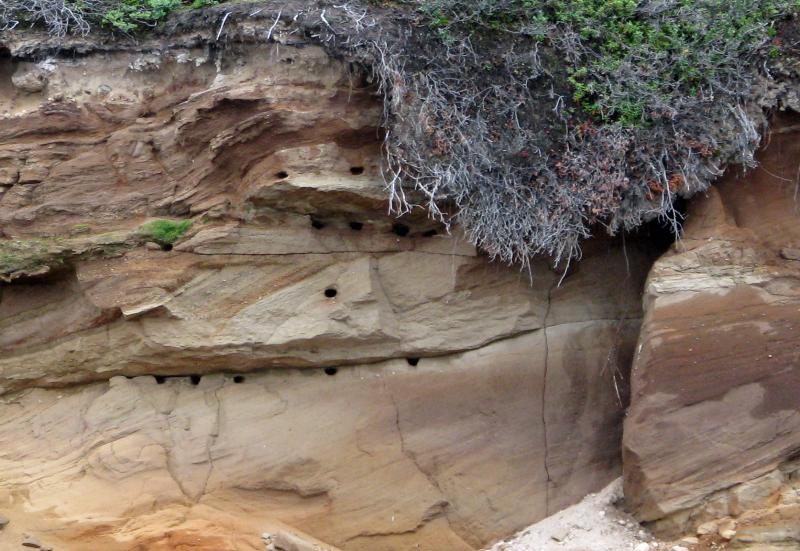We have written before about the decline of swallows and other birds that eat insects that they catch in flight. Species like barn swallows, cliff swallows and tree swallows are well known to most people because they typically nest near us humans, on buildings or in nest boxes. Purple martins are in that category as well but are found in only a few places around the state where they nest in large, specially built, multi-holed martin houses.
There are two additional swallow species that nest in Maine. One is the bank swallow, a small swallow with brown uppersides and white undersides, with a single brown band across its upper chest. As its name suggests, the bank swallow nests in earthen banks, building a tunnel ending in a small cavity. When they find a good spot, bank swallows tunnel their nesting holes near each other, creating a colony, the bank covered with small, dark, circular holes. Often times favorite bank swallow banks are located in gravel pits, or along the shore of a river or the ocean where erosion has exposed a fresh, vertical face of soil or compacted sand. Bank swallows will use these sites over multiple years if the bank remains stable and doesn’t erode away or collapse, but the nature of such sites is that they often don’t last longer than a few years.
Like other swallows, bank swallows are declining. Fortunately, they are also quite adaptable because of the nature of their ephemeral nesting sites; when they find a favorable place, there can sometimes be dozens nesting there.
This is not true for the very similar-appearing but much rarer northern rough-winged swallow. Like the bank swallow, this species is muddy brown on the uppersides and white underneath. But the rough-winged swallow doesn’t have the brown chest band. Instead it has a dusky throat fading into the white chest.
The northern rough-winged swallow also shares the bank swallow’s preference for nesting in holes. However, it doesn’t excavate holes itself; instead, uses an old kingfisher or bank swallow cavity. That habit has apparently made it more able to adapt to nesting in human-made holes, like drainage pipes, or in nooks and crannies under bridges or along walls near water. More often than not, only a single pair of rough-winged swallows will nest in a location, although occasionally large numbers will find nesting sites nearby. But they are almost never in the abundance seen at a bank swallow colony.
Northern rough-winged swallows expanded northward into New York and New England beginning in the late 1800s and continuing through the 1900s. They were first confirmed breeding in Maine in Ogunquit in 1941, and by the late 1950s they were found north to Newry, Skowhegan, Old Town, and Ellsworth. Northern rough-winged swallows have been found north into Aroostook County a few times but they are generally confined to river valleys in the southern half of the state. Nowhere can they be said to be common and even in the few places where they nest, numbers are typically less than 10. For some reason they seem to avoid the Boothbay Peninsula, as there are only a handful of records but they have nested in Wiscasset, Dresden, and Damariscotta.
It is hard to say whether the northern rough-winged swallow or the purple martin deserves to be called Maine’s rarest breeding swallow. Purple martins nest in fewer locations, but where they do nest, they occur in colonies. Northern rough-winged swallows occur in more single locations but there are typically fewer at each location.
As we’ve said before, if you find these (or really any other bird) that you think may be nesting, be sure to input the sighting into the Maine Breeding Bird Atlas through eBird, at https://ebird.org/atlasme/home.
Jeffrey V. Wells, Ph.D., is a Fellow of the Cornell Lab of Ornithology. Dr. Wells is one of the nation's leading bird experts and conservation biologists and author of “Birder’s Conservation Handbook”. His grandfather, the late John Chase, was a columnist for the Boothbay Register for many years. Allison Childs Wells, formerly of the Cornell Lab of Ornithology, is a senior director at the Natural Resources Council of Maine, a nonprofit membership organization working statewide to protect the nature of Maine. Both are widely published natural history writers and are the authors of the book, “Maine’s Favorite Birds” and the newly published “Birds of Aruba, Bonaire, and Curaçao” from Cornell Press.

























